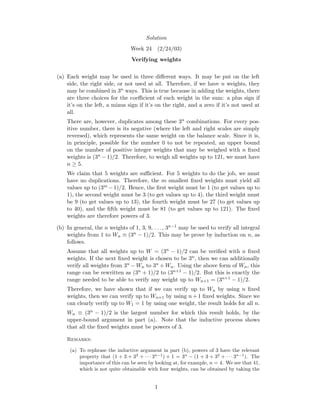
Sol24
- 1. Solution Week 24 (2/24/03) Verifying weights (a) Each weight may be used in three different ways. It may be put on the left side, the right side, or not used at all. Therefore, if we have n weights, they may be combined in 3n ways. This is true because in adding the weights, there are three choices for the coefficient of each weight in the sum: a plus sign if it’s on the left, a minus sign if it’s on the right, and a zero if it’s not used at all. There are, however, duplicates among these 3n combinations. For every pos- itive number, there is its negative (where the left and right scales are simply reversed), which represents the same weight on the balance scale. Since it is, in principle, possible for the number 0 to not be repeated, an upper bound on the number of positive integer weights that may be weighed with n fixed weights is (3n − 1)/2. Therefore, to weigh all weights up to 121, we must have n ≥ 5. We claim that 5 weights are sufficient. For 5 weights to do the job, we must have no duplications. Therefore, the m smallest fixed weights must yield all values up to (3m −1)/2. Hence, the first weight must be 1 (to get values up to 1), the second weight must be 3 (to get values up to 4), the third weight must be 9 (to get values up to 13), the fourth weight must be 27 (to get values up to 40), and the fifth weight must be 81 (to get values up to 121). The fixed weights are therefore powers of 3. (b) In general, the n weights of 1, 3, 9, . . . , 3n−1 may be used to verify all integral weights from 1 to Wn ≡ (3n − 1)/2. This may be prove by induction on n, as follows. Assume that all weights up to W = (3n − 1)/2 can be verified with n fixed weights. If the next fixed weight is chosen to be 3n, then we can additionally verify all weights from 3n − Wn to 3n + Wn. Using the above form of Wn, this range can be rewritten as (3n + 1)/2 to (3n+1 − 1)/2. But this is exactly the range needed to be able to verify any weight up to Wn+1 = (3n+1 − 1)/2. Therefore, we have shown that if we can verify up to Wn by using n fixed weights, then we can verify up to Wn+1 by using n+1 fixed weights. Since we can clearly verify up to W1 = 1 by using one weight, the result holds for all n. Wn ≡ (3n − 1)/2 is the largest number for which this result holds, by the upper-bound argument in part (a). Note that the inductive process shows that all the fixed weights must be powers of 3. Remarks: (a) To rephrase the inductive argument in part (b), powers of 3 have the relevant property that (1 + 3 + 32 + · · · 3n−1 ) + 1 = 3n − (1 + 3 + 32 + · · · 3n−1 ). The importance of this can be seen by looking at, for example, n = 4. We see that 41, which is not quite obtainable with four weights, can be obtained by taking the 1
- 2. fifth weight, 81, and subtracting off the highest possible sum with four weights, namely 40. (b) Consider the following question: You wish to pick n pairs of equal weights (for example, if n = 3, you might pick weights of 1, 1, 4, 4, 11, 11) such that you can verify any positive integer weight up to W. How should you choose the weights in order to maximize W? Along the lines of the reasoning in part (a), we observe that each pair of weights may be used in five ways: We may put (1) both on the left side, (2) one on the left and none on the right, (3) one on each side or use neither, (4) one on the right and none on the left, or (5) both on the right. Therefore, the weights may be used in 5n ways. As above, however, there are duplicates among these 5n combinations. For every positive number, there is its negative, which represents the same weight on the balance scale. Since it is, in principle, possible for the number 0 to not be repeated, an upper bound on the number of positive integer weights that may be weighed with n pairs of fixed weights is (5n − 1)/2. It is indeed possible to achieve W = (5n − 1)/2, by choosing the weights to be powers of 5. The weights should be 1, 1, 5, 5, 25, 25, . . .. Powers of 5 have the relevant property that 2(1+5+52 +· · · 5n−1 )+1 = 5n −2(1+5+52 +· · · 5n−1 ). For example, if n = 3. We see that 63, which is not quite obtainable with three pairs of weights, can be obtained by taking a weight from the fourth pair, namely 125, and subtracting off the highest possible sum obtainable with three pairs, namely 62. In general, if we use n k-tuplets of weights, it is possible to verify any positive integer weight up to [(2k +1)n −1]/2. The weights should be powers of (2k +1). 2
